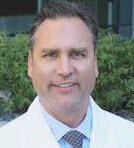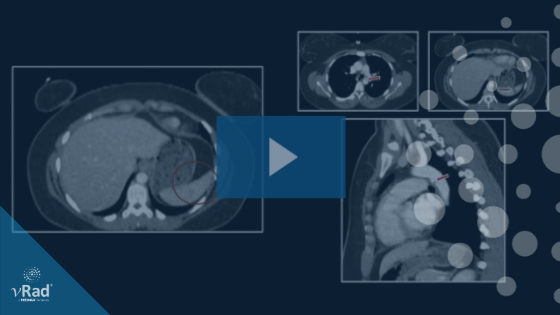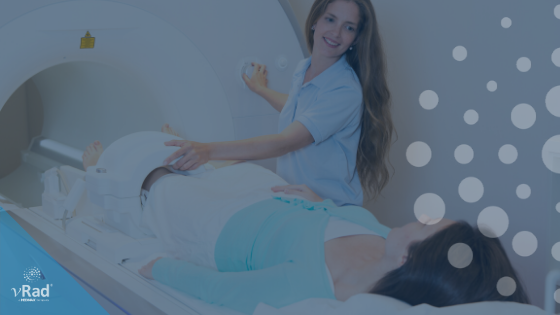8 Must-Know CV Tips for Radiologists—Whether Job Hunting or Not
If your Curriculum Vitae isn’t all it could be, you may as well be stacking trophies in a cave. I say this as a longtime radiologist recruiter who...

Remote radiologist jobs with flexible schedules, equitable pay, and the most advanced reading platform. Discover teleradiology at vRad.

Radiologist well-being matters. Explore how vRad takes action to prevent burnout with expert-led, confidential support through our partnership with VITAL WorkLife. Helping radiologists thrive.

Visit the vRad Blog for radiologist experiences at vRad, career resources, and more.

vRad provides radiology residents and fellows free radiology education resources for ABR boards, noon lectures, and CME.

Teleradiology services leader since 2001. See how vRad AI is helping deliver faster, higher-quality care for 50,000+ critical patients each year.

Subspecialist care for the women in your community. 48-hour screenings. 1-hour diagnostics. Comprehensive compliance and inspection support.

vRad’s stroke protocol auto-assigns stroke cases to the top of all available radiologists’ worklists, with requirements to be read next.

vRad’s unique teleradiology workflow for trauma studies delivers consistently fast turnaround times—even during periods of high volume.

vRad’s Operations Center is the central hub that ensures imaging studies and communications are handled efficiently and swiftly.

vRad is delivering faster radiology turnaround times for 40,000+ critical patients annually, using four unique strategies, including AI.
.jpg?width=1024&height=576&name=vRad-High-Quality-Patient-Care-1024x576%20(1).jpg)
vRad is developing and using AI to improve radiology quality assurance and reduce medical malpractice risk.

Now you can power your practice with the same fully integrated technology and support ecosystem we use. The vRad Platform.

Since developing and launching our first model in 2015, vRad has been at the forefront of AI in radiology.

Since 2010, vRad Radiology Education has provided high-quality radiology CME. Open to all radiologists, these 15-minute online modules are a convenient way to stay up to date on practical radiology topics.

Join vRad’s annual spring CME conference featuring top speakers and practical radiology topics.

vRad provides radiology residents and fellows free radiology education resources for ABR boards, noon lectures, and CME.

Academically oriented radiologists love practicing at vRad too. Check out the research published by vRad radiologists and team members.

Learn how vRad revolutionized radiology and has been at the forefront of innovation since 2001.

%20(2).jpg?width=1008&height=755&name=Copy%20of%20Mega%20Nav%20Images%202025%20(1008%20x%20755%20px)%20(2).jpg)

Visit the vRad blog for radiologist experiences at vRad, career resources, and more.


Explore our practice’s reading platform, breast imaging program, AI, and more. Plus, hear from vRad radiologists about what it’s like to practice at vRad.

Ready to be part of something meaningful? Explore team member careers at vRad.
7 min read
Samir Ferdowsi : January 12, 2018

Remember fidgeting in bed, waiting to open the greatest present you ever asked for the night before your birthday? Or how about sitting in high school, nervously anticipating whether or not “studying” paid off, as the teacher passed out a chapter exam? Now combine the two, sprinkle in a touch of indecisiveness, increase the stakes indefinitely and what do you get?
Choosing a career path while at university.
For all of us students out there, nothing is more daunting than choosing the right profession. So many choices, so many classes – the mind wasn’t meant for this. I feel you. But, as we all come to learn – whether we like it or not – the juvenility of our first year September days slowly gets erased, one lecture, one career counseling meeting at a time. In the end, I think we all can agree that this is a good thing, but this highway is laden with traffic jams filled with unease, contemplation, even excitement and above all anticipation. Whether you are going into journalism, medical school, accounting or anything in-between – it turns out the journey to your profession is just as important as the final destination.
During my time at vRad, I had the opportunity to ask a few professionals to weigh-in on what it takes to become a radiologist – and today I’ll share one of their journeys. I hope that this perspective helps shed some light on the road that may seem covered with mystery at the moment. From initially going into environmental science, to finding their calling through a postcard, a radiologist rarely has a straight path to their reading room – but from what I can tell, most love it when they finally arrive.
With our best foot forward, introducing, Dr. Matthew Zapala.
 Currently working as an assistant professor at the University of California, San Francisco (USCF), Dr. Zapala specializes in pediatric radiology. Along with doing research, teaching medical students, residents and fellows, Dr. Zapala interprets imaging studies for pediatric patients at UCSF’s two Children’s Hospitals in San Francisco and Oakland. He also lectures at radiology courses around the country and will be speaking at his second vRad CME conference in Las Vegas in 2018.
Currently working as an assistant professor at the University of California, San Francisco (USCF), Dr. Zapala specializes in pediatric radiology. Along with doing research, teaching medical students, residents and fellows, Dr. Zapala interprets imaging studies for pediatric patients at UCSF’s two Children’s Hospitals in San Francisco and Oakland. He also lectures at radiology courses around the country and will be speaking at his second vRad CME conference in Las Vegas in 2018.
While Dr. Zapala is exceptionally satisfied with where he has landed, his road was anything but straight. This seems to be a common motif in all radiologists’ journeys.
“I went to college thinking I was going to pursue medicine, but when I got to college there was a lot of exciting stuff, I wasn’t sure if I wanted to go into medicine after I graduated anymore.”
Instead, he chose to try environmental science. After graduating with a degree in biology, Dr. Zapala worked for an environmental consulting firm (all the while churning the notion of attending medical school in the back of his mind). Yet, after two years in the field, the thought of becoming a doctor wouldn’t leave his mind. So, he decided to dust off his original goal and make the leap into medicine.
“Environmental science was great and I am glad that I tried it, but I always kept thinking about medicine, and never really stopped thinking about it.”
With a surge of renewed passion, he used his biology degree to study for, and consequently pass, the MCAT exam, which allowed him to enter medical school at the University of California, San Diego (UCSD). He argued that going with one’s true and most genuine devotion is the road to career satisfaction. He was in and following his dream.
But, also according to Dr. Zapala, a speed bump arose that is common for all newly admitted med students: you’re going to be a doctor, yes. ‘But what kind?’
“All of medical training is a long, hard road. When you’re in medical school choosing your career takes a lot of work and takes a lot of years – it’d be a shame if you get to the end of that road and don’t like what you do.”
For Dr. Zapala, medical school held many eye-opening experiences that brought him to his final career path – not only from a medical standpoint—but from a life lesson standpoint as well.
The program at USCD that he enrolled in had a unique twist – something that should be noted about medical schools – each has its own twist. Dr. Zapala was part of the Medical Scientist Training Program (MSTP) at UCSD, a federally funded NIH program that is designed to produce physician-scientists who have both clinical training and rigorous research training. The government pays for medical school and provides a stipend while in school. The program is:
Once he completed his PhD program and reentered the med school track, Dr. Zapala said he started to acclimate towards a specialty he found fitting.
“In my third year of medical school, I think I pretty much realized that I really liked the thinking aspect of radiology. I finally got to use a lot of my medical training. A radiologist gets to interact with a lot of different medical specialists (orthopedists, ENTs, neurosurgeons, rheumatologists) and a lot of different clinical problems. I loved that.”
Here is where Dr. Zapala explained to me a very important part of anyone’s professional search.
First, the people you are surrounded by in your training/school will influence your job choice – it’s inevitable.
“You go into medical school and you go into a rotation and are like ‘hmm, this is not as fun or exciting as I thought it would be’ and it may just be the team of people you are working with. If you did that rotation at another hospital with a different group of people it may be a completely different experience. So be aware of that.”
As hard as this statement is to believe for someone who likes to think they march to their own drum, the more I thought about it, the more I absorbed these words. One is influenced by his/her environment; and what creates the environment around one at school is your peers, teachers and mentors.
I realized that this impact-of-colleagues can be interpreted either positively or negatively. For a “glass-half-empty” person, you could take Dr. Zapala’s statement as ‘conformity is inevitable and I will never truly carve out my own path in life’ – millennial despair at its finest. For a “glass half-full” person, you could see the situation as an opportunity to make sure that what you’re doing is truly a passion. In other words, a group project shouldn’t determine your affinity towards any subject – especially your livelihood.
As far off as it seems when you step foot on campus for orientation, graduation day does come. All of the countless labs, lectures and reports finally equate to a piece of paper that denotes your specialized educational prowess. Throughout the years, we certainly gain a plethora of knowledge – in both street and book smarts. However, when talking about radiology, Dr. Zapala had wise words that might surprise anyone interested in the imaging field:
“I would say that communication is actually, almost arguably more important than visual aptitude.”
If you’re reading this, I am assuming that you know what a radiologist does. In turn, you also know then that the profession’s foundation is built on interpreting clinical images to discover findings and abnormalities—which are typically difficult to discern in subtle shades of gray. So, being someone who is not in the medical field, I figured that “visual aptitude” would be the primary tool a successful radiologist would utilize in their arsenal. But as Dr. Zapala highlighted, this is not the only core skill required.
Because a radiologist is in constant collaboration – and interacting with nearly every other department in a healthcare facility – they must know how to communicate their findings, Dr. Zapala said. Just filling out a conventional report rarely paints the whole picture. “You can’t just point at the problem and say ‘that’s the problem!’ You have to describe what it is, put it in a clinical context, and then report it in a way that is not confusing – helping the other doctors, your clinical colleagues, out.”
An interesting tidbit that aspiring radiologists should keep in mind.
Now that you’ve gotten your white coat and completed your formal medical school training, it is time to enter the big leagues. The radiology industry, from what I have learned, seems to be one that is constantly evolving – even on a daily basis.
According to Dr. Zapala, in the years since he has been out of training, technology has noticeably advanced in the radiology arena and is transforming in fascinating ways.
“Radiology is driven by technology and the future is exciting. Machine learning and artificial intelligence is really going to change how I work. I’m optimistic that it will change for the better. It will eliminate some of the mundane tasks and make my job more enjoyable. As radiologists we understand medical imaging better than anyone and we will have to remain engaged and active as these technological changes advance our field.”
As with any industry in this 2.0 world, radiology has been taken by the technology wave in full force. During my time at vRad, I’ve noticed that the entire industry relies on technology to operate. Advancing technology is something that vRad values, and in my sincere opinion, I think the strides vRad is making benefit the entire field of radiology. From the operations center, to credentialing policies, to a radiologist’s reading station – vRad uses technology to speed up routine work that in turn frees up time to focus on diagnosis and patient care.
vRad is the leading teleradiology practice in the U.S. Teleradiology is the practice of transmitting radiological patient images such as X-rays, CTs and MRIs from a medical center to a remote radiologist, who then interprets the images and returns a clinical report. While at first this may sound counterproductive (it sure did to me): having the ability to send images to specialty-trained radiologists when you might not have the specialist you need on hand, or simply no one on hand? It’s genius.
Dr. Zapala explained that the reach teleradiology provides is what makes it an ace-in-the-hole within the medical field.
“I completed my residency at UCSD and we got to see interesting cases from all over the country, and even the world. We actually had a set up with Mozambique that allowed us to provide care to patients in Africa. Teleradiology extends the practice of radiology to places that may not have the necessary expertise or personnel available.”
This is the sort of technology that makes the medical field exciting, in my opinion.
Now, being the student journalist, I have to be sure to cover both sides of the parchment. Dr. Zapala did bring to light negative effects, cons if you will, of teleradiology.
“A lot of what I do on a daily basis, as an academic radiologist, is talk with clinicians – and I have a personal relationship with them. I get to know them and they get to know me. You may be able to develop that with teleradiology but it is a little more difficult given limited face-to-face interactions. There are things I may discuss with a clinician who trusts me that I may not mention directly in a report. You may learn more about the patient from these face-to-face discussions with the clinicians that may inform your image interpretation.”
While some practices use video chat tools such as Skype, this definitely caught my eye as an interesting angle to take on reading images. As a teleradiologist, you are “alone” but really, you can surround yourself with whomever you please. The sea of choices is endless; your family, your dog, your cactus collection – you are remote, the world is your oyster! Yet, Dr. Zapala raises a notable point – for better or worse, the teleradiology work environment is undoubtedly different.
All in all, Dr. Zapala highly encourages looking into radiology as a profession for those interested in the medical field. If you enter med school with an open mind (all the while remembering the environment you’re in), your path will reveal itself in time. As a student who was interested in technology and science as a whole, I have to say, the magnitude of the radiology field really comes into focus.
Funny enough, it turns out, my path had crossed with vRad’s before this summer. The idea that I could break my wrist while snowboarding and then be taken to the ER to have an X-ray read by a remote radiologist (because none were on duty in this rural town) never crossed my mind – yet this happened to me. And I’ve recently learned that my images were almost certainly read by a vRad radiologist—and I’m pleased to report, I’ve fully recovered.
Whatever part of the professional world you choose to join, I wish you the best of luck and hope that you enjoy the journey.

If your Curriculum Vitae isn’t all it could be, you may as well be stacking trophies in a cave. I say this as a longtime radiologist recruiter who...

Since 2010, vRad has provided high-quality, free continuing medical education – but I’ve always thought that there was an opportunity to share more...

MEDNAX expanded its radiology strategy to include both on-site and teleradiology services with the acquisition of Radiology Alliance, PC and Infinity...
vRad (Virtual Radiologic) is a national radiology practice combining clinical excellence with cutting-edge technology development. Each year, we bring exceptional radiology care to millions of patients and empower healthcare providers with technology-driven solutions.
Non-Clinical Inquiries (Total Free):
800.737.0610
Outside U.S.:
011.1.952.595.1111
3600 Minnesota Drive, Suite 800
Edina, MN 55435